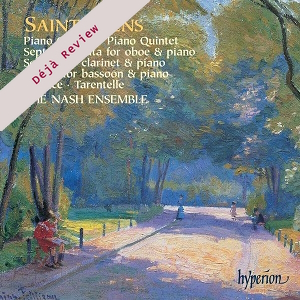
Déjà Review: this review was first published in June 2005 and the recording is still available.
Camille Saint-Saëns (1835–1921)
Chamber Music
The Nash Ensemble
rec. 2004, Henry Wood Hall, London
Hyperion CDA67431-2 [2 CDs: 134]
Camille Saint-Saëns is one of those composers whose fame now rests largely if not exclusively on just a few works, the Symphony No. 3 ‘Organ’, Symphonic Poem, Danse macabre and The Carnival of the Animals. From an early age, Saint-Saëns composed prolifically and seemingly without effort. He once said. “I produce music like an apple tree produces apples.” Throughout his long life of eighty-six years, Saint-Saëns wrote in all genres, including symphonies, concertos, sacred and secular choral music, thirteen operas, chamber music, numerous songs and solo pieces for piano and organ.
When Saint-Saëns was born in Paris in 1835 Mendelssohn had twelve more years to live. When he died in Algiers in 1921 Stravinsky’s Rite of Spring was already eight years old. Sadly, by the time of his death Saint-Saëns’ popularity in France had diminished significantly. Around the time of the Great War, public taste in music had changed. However, the music of the multi-talented Saint-Saëns has for a number of years been undergoing a welcome resurgence to which the Hyperion label have significantly contributed thanks to their award-winning set of The Complete Works for Piano and Orchestra recorded in 2000-01 by Stephen Hough and the CBSO under Sakari Oramo on CDA67331/2. One only has to hear the Piano Trios Nos 1 and 2 by the Joachim Trio on Naxos 8.550935 to be aware of the many magnificent scores that await general discovery.
Thankfully, this captivating new release will go some way to further promote the case. This generous and captivating selection, spanning sixty-four years, is outstanding and must surely be one of my records of the year.
Saint-Saëns frequently wrote for the instrumental forces available to him. The set opens with a rare Septet for trumpet, string quintet and piano. The score is from 1880 and was the result of a playful commission from a chamber music society known as ‘La Trompette’. It is a jaunty work embracing seventeenth-century dance forms within a neoclassical style. Perhaps fortunately, the composer appears never to have fulfilled his original promise to the society to compose a piece for guitar and thirteen trombones. What wonderful and expressive writing … and the ensemble play with a passionate lyricism and a sureness of tone throughout.
The early Piano quintet in A minor from 1855 exudes a youthful confidence and swagger, the piano part leading the way, while the quartet quickly established itself as a staple of the repertory. The piano plays a dominant virtuoso role, often in opposition to the string quartet, but also engaging in dialogue, ensemble, contrapuntal and unison passages. This is a compelling performance with rhythmic intensity and superb attention to detail.
The Piano Quartet in B-flat major, Op 41 dates from 1875. This quartet was actually Saint-Saëns’ second complete piano quartet. In 1851–3 he had written a Piano Quartet in E major which he performed but which was not published until it was recently resurrected and published in 1992.
The Piano Quartet continues to be a core work in the repertoire for violin, viola, cello and piano and this glorious performance is stylish and vibrant.
In 1921, the last year of his life, Saint-Saëns set out to compose sonatas for each of the main woodwind instruments and piano. Those for cor anglais and flute were never written, but Saint-Saëns wrote the three Sonatas for oboe, bassoon and clarinet. The wonderful Tarantelle for flute, clarinet and piano was composed in 1857. A Caprice sur des airs danois et russes for piano, flute, oboe and clarinet (1887) delightfully combines Danish and Russian themes. The sonorities of piano and wind instruments conclude the programme. One is in awe at the composer’s ability to write with such attractive character, musical variety and impeccable charm. The soloists offer fresh, thoughtful and invigorating accounts that serve the composer admirably throughout.
The sound quality from the Hyperion engineers is of the highest standard, as are the booklet notes by Sabina Teller Ratner.
A wonderfully presented release that is highly recommended. One of my records of the year.
Michael Cookson
Help us financially by purchasing from


Contents
Septet in E-flat major for piano, trumpet, two violins, viola, cello and double bass, Op 65 (1880)
Tarantelle in A minor for flute, clarinet and piano, Op 6 (1857)
Bassoon Sonata in G major, Op 168 (1921)
Piano Quartet in B-flat major, Op 41 (1875)
Piano Quintet in A minor, Op 14 (1855)
Oboe Sonata in D major, Op 166 (1921)
Clarinet Sonata in E-flat major, Op 167 (1921)
Caprice sur des airs danois et russes for piano, flute, oboe and clarinet, Op 79 (1887)

















